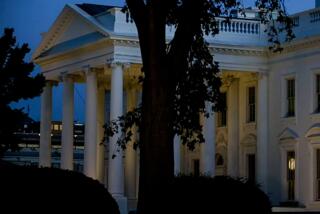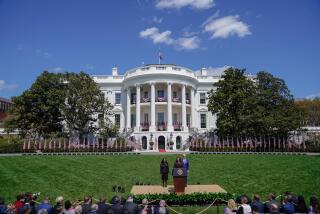No Harm From ‘Spy Dust’ Yet, Embassy Says
- Share via
MOSCOW — The U.S. Embassy told Americans in Moscow on Wednesday that there is no evidence so far of any ill effects to health from the Soviet Union’s use of a chemical to track the movements of U.S. diplomats here.
However, the embassy called in Americans to issue a warning that they may suffer health hazards from the use of the chemical by the KGB security police. A State Department doctor said he sees no reason for “great concern,” on the basis of present information.
The reaction was divided between skepticism--tinged with humor--and deep apprehension that the mysterious substance might cause harm to children or pregnant women. The substance was instantly dubbed “spy dust” by some members of the American press corps here.
Extraordinary Briefing
In the absence of vacationing Ambassador Arthur A. Hartman, Richard Coombs, the deputy chief of mission and charge d’affaires of the embassy, presided at the extraordinary nighttime briefing for private citizens and members of the embassy staff.
Giving details worthy of a spy thriller, he charged that the KGB has been sprinkling tiny amounts of a yellow-white powder “indirectly” on American diplomats in an effort to learn more about their activities in Moscow. The powder reportedly has been found on door knobs, automobile steering wheels and other objects the diplomats are likely to touch.
But Coombs said he does not know how the secret police have been able to shadow diplomats by means of the synthetic chemical, which he labeled NPPD. The full name of the chemical is nitrophenylpentadiene.
Remark Draws Laughter
“Do you mean my maid put a little of this powder in my shorts when she did the wash?” one man asked, drawing laughter from the crowd of 75 Americans gathered in Spaso House, the ambassador’s residence.
But Coombs tenaciously refused to say where the powder had been found despite a questioner’s assertion that he would not be disclosing any sensitive information because the KGB already knew where it had placed the chemical.
“But the KGB might not know we know where they put it,” Coombs replied.
Jane Thatcher, wife of correspondent Gary Thatcher of the Christian Science Monitor, said she was worried about the possible impact on the health of her 2-year-old son, Jason.
Dr. Charles Brodine, a top medical officer of the State Department who flew to Moscow to assist in the briefings, told her there was not enough data yet to evaluate the health hazard. He suggested that mothers use plenty of soap and water on their children, along with a cleansing solution containing alcohol to neutralize any possible contact with the chemical.
“Based on present information, there is no cause for alarm or great concern,” Brodine said. But he added quickly that the results of a lengthy series of animal tests would provide a better basis for evaluating the risk.
Brodine, a white-haired man with an easy manner, said he would be more concerned about Americans in Moscow who drive without a seat belt or smoke a lot of cigarettes.
He said that only billionths of a gram weight of the chemical are used in the alleged tracking plot--an amount that he indicated is too little to cause serious damage.
Brodine indicated that little is known about NPPD and said that only six scientific papers have been written about it, none of them by Americans.
A Marine sergeant, assigned to the embassy’s security detail, brushed off any possible health consequences, saying: “I served a tour in Vietnam and there was Agent Orange and all that, so I consider this to be just another hazard in this assignment.”
Some correspondents here tended to doubt that there is much danger from the chemical because they remember initial American warnings about the health impact of microwave radiation allegedly beamed by the KGB at the U.S. Embassy from the 1960s until 1978. The State Department eventually concluded that the radiation was harmless to embassy employees, although it may have been useful to Soviet eavesdroppers.
In addition, there seemed to be little that anyone could do about the powder-sprinkling even if he or she is a target. “There is no easy way to detect this except to see it,” Coombs said, adding that it was odorless and used in very small amounts.
The Americans in Moscow will be asked to cooperate with a team of experts from the National Institutes of Health and the Environmental Protection Agency when it arrives in Moscow later this month, he said.
But he laughed off a housewife’s suggestion that yellow particles in her apartment--labeled as cockroach powder--might instead be the suspected chemical by joking, “If you have found some roach powder that works, let me know.”
More to Read
Sign up for Essential California
The most important California stories and recommendations in your inbox every morning.
You may occasionally receive promotional content from the Los Angeles Times.












